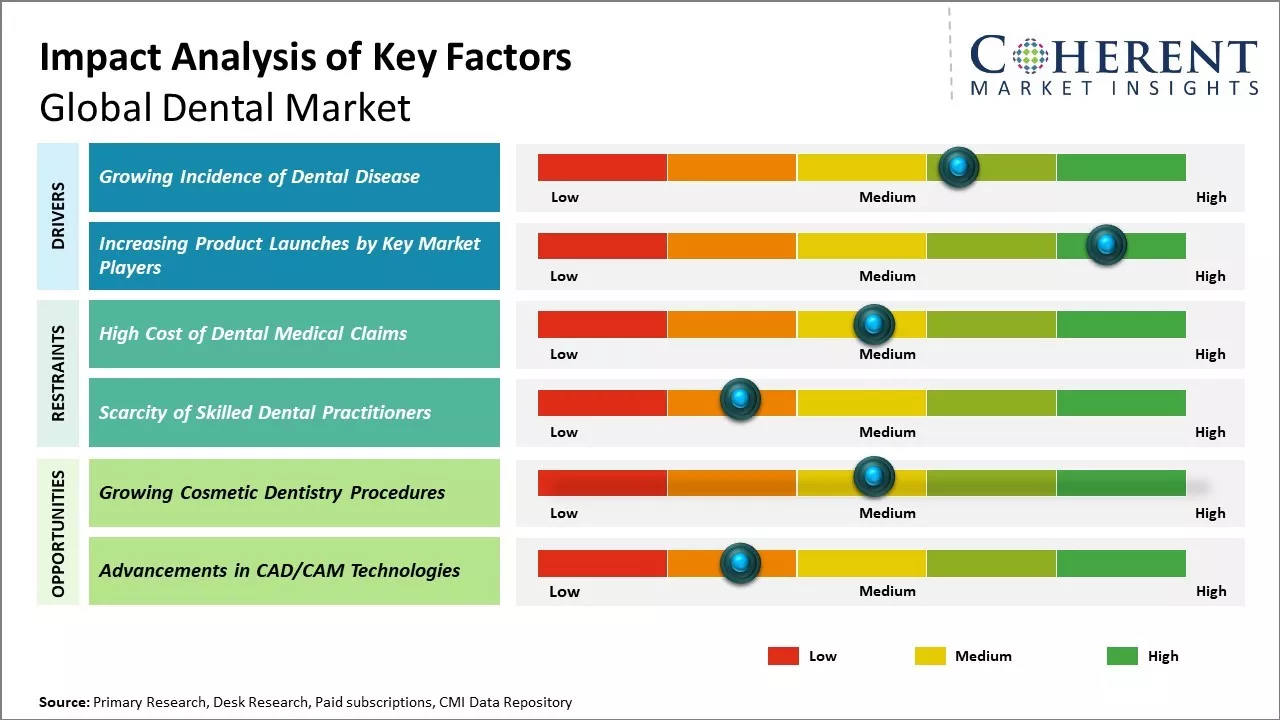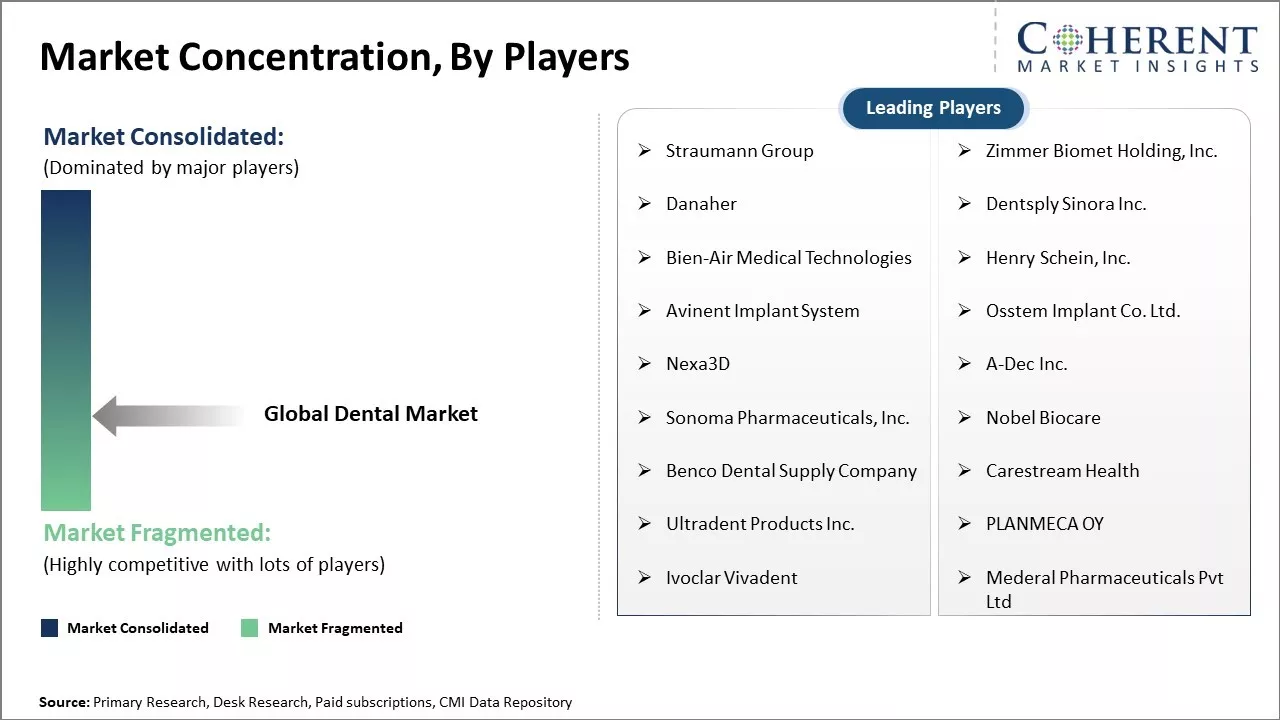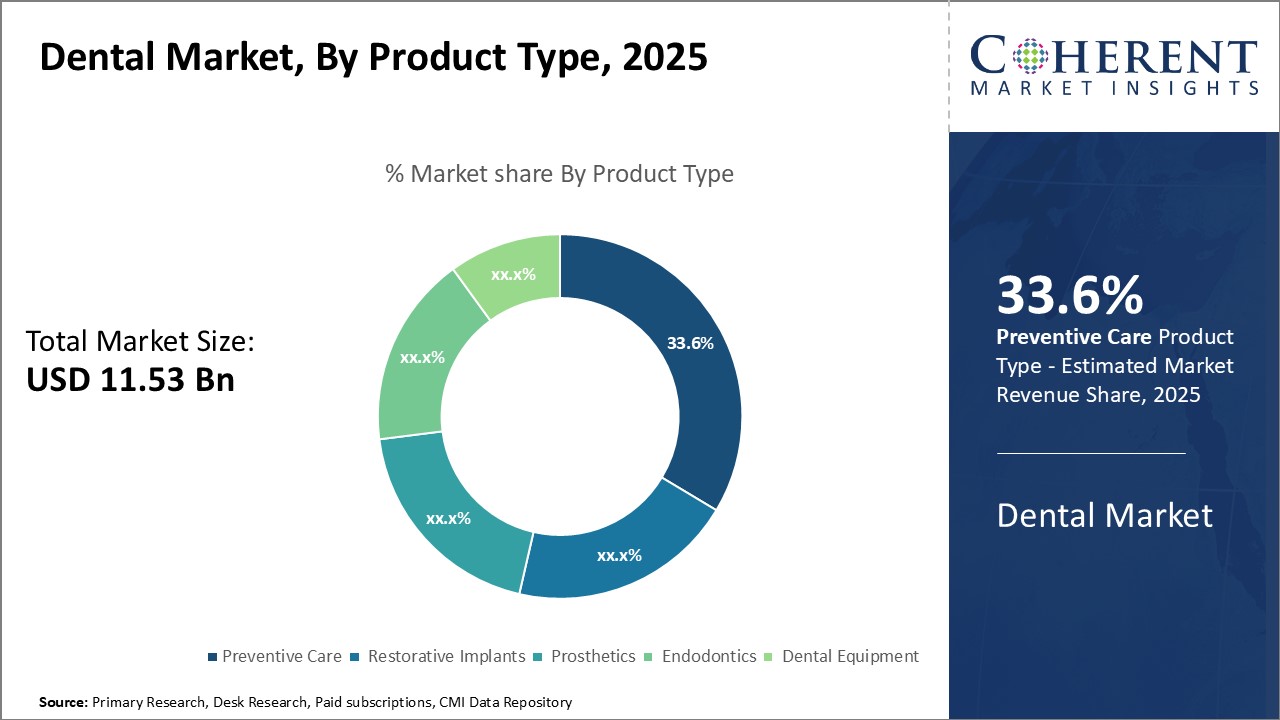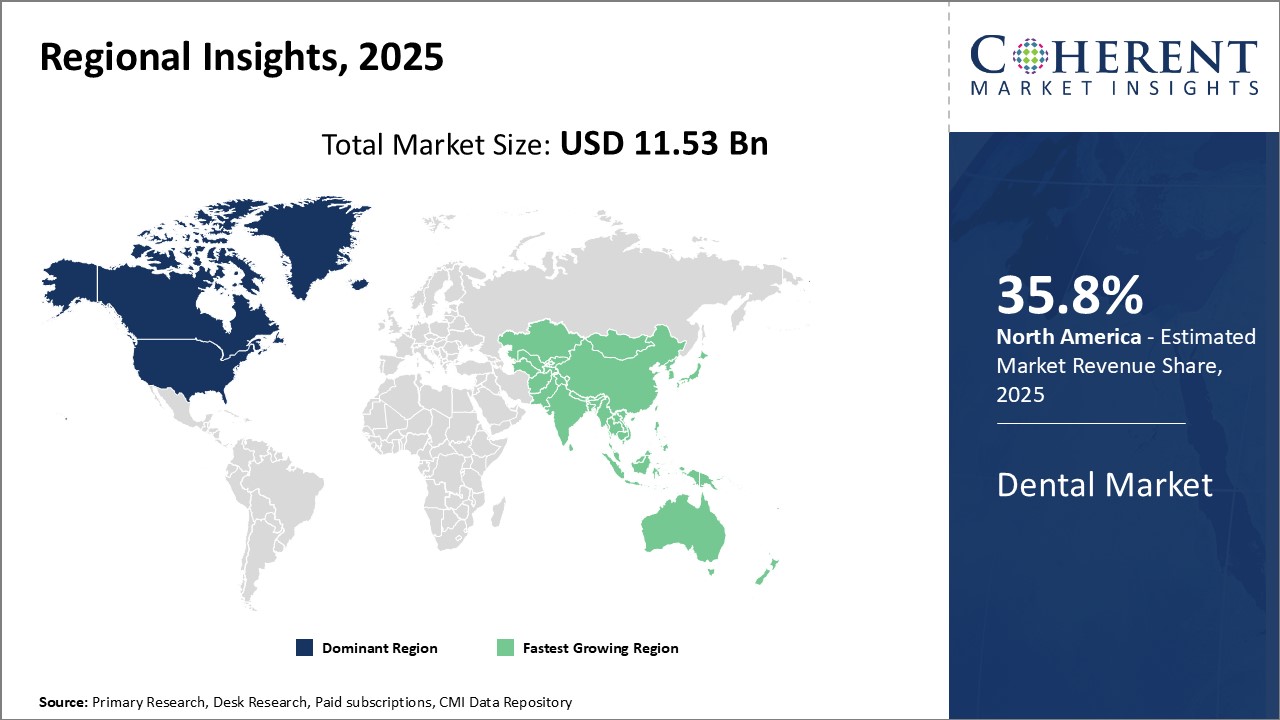Global dental market is estimated to be valued at USD 11.53 Bn in 2025 and is expected to reach USD 19.13 Bn by 2032, exhibiting a compound annual growth rate (CAGR) of 7.5% from 2025 to 2032.

Discover market dynamics shaping the industry: Request sample copy
Global dental market is witnessing positive trends like increased adoption of dental implants and rising demand for cosmetic dentistry. More people are opting for dental veneers, teeth whitening, and straightening to enhance their appearance. There is also growth in invisible orthodontics using clear aligners. Aging population and increased focus on preventive dental care can offer market opportunities. With increased access and growing dental tourism, the market is expected to witness growth in the near future.
Growing Incidence of Dental Disease
Rising prevalence of oral diseases due to growing urbanization and changes in living conditions is expected to drive the market growth. Most cases are dental caries (tooth decay), periodontal diseases, tooth loss, and oral cancers. Thus, increasing incidence of dental diseases is expected to drive the market growth in near future. For instance, in March 2023, according to the WHO Global Oral Health Status Report (2022), oral diseases affects 3.5 billion people worldwide, with 3 out of 4 people affected living in middle-income countries 2 billion people suffer from caries of permanent teeth globally, and 514 million children suffer from caries of primary teeth.

Get actionable strategies to beat competition: Request sample copy
Increasing Product Launches by Key Market PlayersIncreasing product launches by key market players is expected to drive the market growth over the forecast period. For instance, in February 2023, BIOLASE, Inc., a global leader in dental lasers, announced the U.S. launch of the Waterlase Fractional Handpiece for doctors seeking a faster and more efficient way to perform skin resurfacing.
Key Takeaways from Analyst:
The global dental market is poised to grow steadily driven by rising healthcare expenditure and growing importance of oral healthcare among consumers worldwide. Population aging will propel the demand for dental care services as geriatric population is more prone to dental diseases. Higher focus on dental aesthetics is encouraging more people to spend on cosmetic and restorative procedures. Advancements in dental materials and equipment coupled with the adoption of digital dentistry solutions are enhancing the treatment outcomes, thereby boosting market opportunities.
High cost of dental procedures and limited medical insurance coverage for dental care in many countries may inhibit faster market growth. Meanwhile, shortage of dentists particularly in developing nations continues to restrict improved access to dental care. The North American region currently dominates the global dental market owing to early technological adoption and presence of leading dental product manufacturers. Asia Pacific is projected to emerge as the fastest growing regional market in the coming years supported by rapidly increasing healthcare spending and growing middle-class population in countries like China and India.
Regulatory frameworks should focus on increasing the number of trained dental professionals through educational initiatives in order to bridge the demand-supply gap worldwide. Collaborations between industry stakeholders and dental associations can help in promoting oral healthcare awareness and facilitating dental insurance penetration.
Market Challenge – High Cost of Dental Medical Claims
High cost of dental medical claims in many countries can hamper the global dental market growth over the forecast period. For instance, in March 2022, according to the article published by BMC Journal, insurance coverage of prosthetic rehabilitation or dentures is time-bound, with coverage intervals ranging between three to five years. Costs for new prosthetic rehabilitation in Lithuania and Estonia are reimbursed up to a maximum of US$ 602.5 and US$ 279.2 (Estonia) every three years, if done by contracted dentists.
Market Opportunity – Growing Cosmetic Dentistry Procedures
Growing cosmetic dentistry procedures is expected to drive the market growth over the forecast period. For instance, in April 2022, according to the data published by Beaches Dental Mona Vale, a dentist, cosmetic dentistry has become more popular, and more dentists are performing this procedure.

Discover high revenue pocket segments and roadmap to it: Request sample copy
Insights, By Product Type: Increasing demand for dental restoration procedures can boost preventive care segment growthProduct Type segment is sub-segmented into preventive care, restorative implants, prosthetics, endodontics, and dental equipment. Preventive Care sub-segment is estimated to hold 33.6% of the market share in 2025, due to increasing demand for dental restoration procedures worldwide. There has been increase in dental issues like tooth loss, decay, and fractures in the recent years, owing to changing lifestyle and dietary patterns. Restorative implants provide a reliable and long-lasting solution for missing teeth replacement and improving aesthetics. The availability of innovative implant designs and biomaterials that ensure faster integration with the jaw bone also drives the uptake of dental implants. Advancements in CAD/CAM technology and computer-guided surgery have made dental implant placement a highly predictable and minimally invasive procedure. This has boosted patient confidence in opting for implants over other tooth replacement options. Further, restorative implants offer superior functional outcomes and quality of life improvements as compared to removable dentures. Growing awareness among consumers about the various benefits of dental implants can boost demand for these implants over other restorative options. The increasing number of cosmetic dentistry procedures has also boosted demand for dental implants. Overall, technological developments and tangible clinical benefits makes restorative implants the treatment of choice, contributing to their largest share in the global dental market.
Insights, By End User: Growing Patient Preference for Receiving Specialized Dental Care And Treatment From Clinics
End User segment is sub-segmented into dental clinics, hospitals and others. Dental Clinics sub-segment is estimated to hold 34.4% of the market share in 2025, owing to growing patient preference for receiving specialized dental care and treatment from clinics rather than hospitals or other settings. Dental clinics are exclusively focused on offering the entire range of dental services, and are therefore usually well-equipped for general as well as advanced procedures. These employ skilled dental professionals like orthodontists, endodontists, prosthodontists, and periodontists who can efficiently handle all types of oral health issues. The availability of latest dental equipment and technology platforms in clinics also attracts more patients. Dental clinics typically have flexible operating hours and appointment systems for better accessibility and convenience of patients. These also provide personalized care through continued patient engagement and exclusive dental records management. The higher levels of privacy, individual attention and targeted expertise offered by clinics have made them the preferred choice over other end users. Overall, the availability of comprehensive and specialized dental services can drive the dental clinics segment growth in the global dental market.

Need a Different Region or Segment? Customize now
North America remains the dominant region in the global dental market and is estimated to hold 35.8% of the market share in 2025 owing to high awareness levels regarding oral hygiene and regular dental checkups in the region. Several leading multinational dental product manufacturers have their presence across major cities in America, thus, offering a wide range of consumer and professional-use products. The American dental association has played a crucial role in promoting oral healthcare through educational programs and campaigns.
Asia Pacific has emerged as the fastest growing regional dental market. China and India provides major opportunities for players looking to expand their footprint in the developing markets. Rising disposable incomes, growing middle class population and changing lifestyles have positively impacted the oral healthcare spending in the region. Governments in various Asian countries have also undertaken various initiatives to improve access to dental services in tier-2 and tier-3 cities. Many international companies have established manufacturing and distribution facilities in Asia to cater to the rising local demand. The pricing of dental materials and equipment is generally lower as compared to developed markets, making dental treatments more affordable for the masses.
Dental Market Report Coverage
| Report Coverage | Details | ||
|---|---|---|---|
| Base Year: | 2024 | Market Size in 2025: | USD 11.53 Bn |
| Historical Data for: | 2020 To 2024 | Forecast Period: | 2025 To 2032 |
| Forecast Period 2025 to 2032 CAGR: | 7.5% | 2032 Value Projection: | USD 19.13 Bn |
| Geographies covered: |
|
||
| Segments covered: |
|
||
| Companies covered: |
Straumann Group, Zimmer Biomet Holding, Inc., Danaher, Dentsply Sinora Inc., Bien-Air Medical Technologies, Henry Schein, Inc., Avinent Implant System, Osstem Implant Co. Ltd., Nexa3D, A-Dec Inc., Sonoma Pharmaceuticals, Inc., Nobel Biocare, Benco Dental Supply Company, Carestream Health, Ultradent Products Inc., PLANMECA OY, Ivoclar Vivadent, Mederal Pharmaceuticals Pvt Ltd |
||
| Growth Drivers: |
|
||
| Restraints & Challenges: |
|
||
Uncover macros and micros vetted on 75+ parameters: Get instant access to report
Share
Share
About Author
Komal Dighe is a Management Consultant with over 8 years of experience in market research and consulting. She excels in managing and delivering high-quality insights and solutions in Health-tech Consulting reports. Her expertise encompasses conducting both primary and secondary research, effectively addressing client requirements, and excelling in market estimation and forecast. Her comprehensive approach ensures that clients receive thorough and accurate analyses, enabling them to make informed decisions and capitalize on market opportunities.
Missing comfort of reading report in your local language? Find your preferred language :
Transform your Strategy with Exclusive Trending Reports :
Frequently Asked Questions
Joining thousands of companies around the world committed to making the Excellent Business Solutions.
View All Our Clients
US Reciprocal Tax Impact Analysis On Dental Market
Stay updated on tariff changes with expert insights and timely information